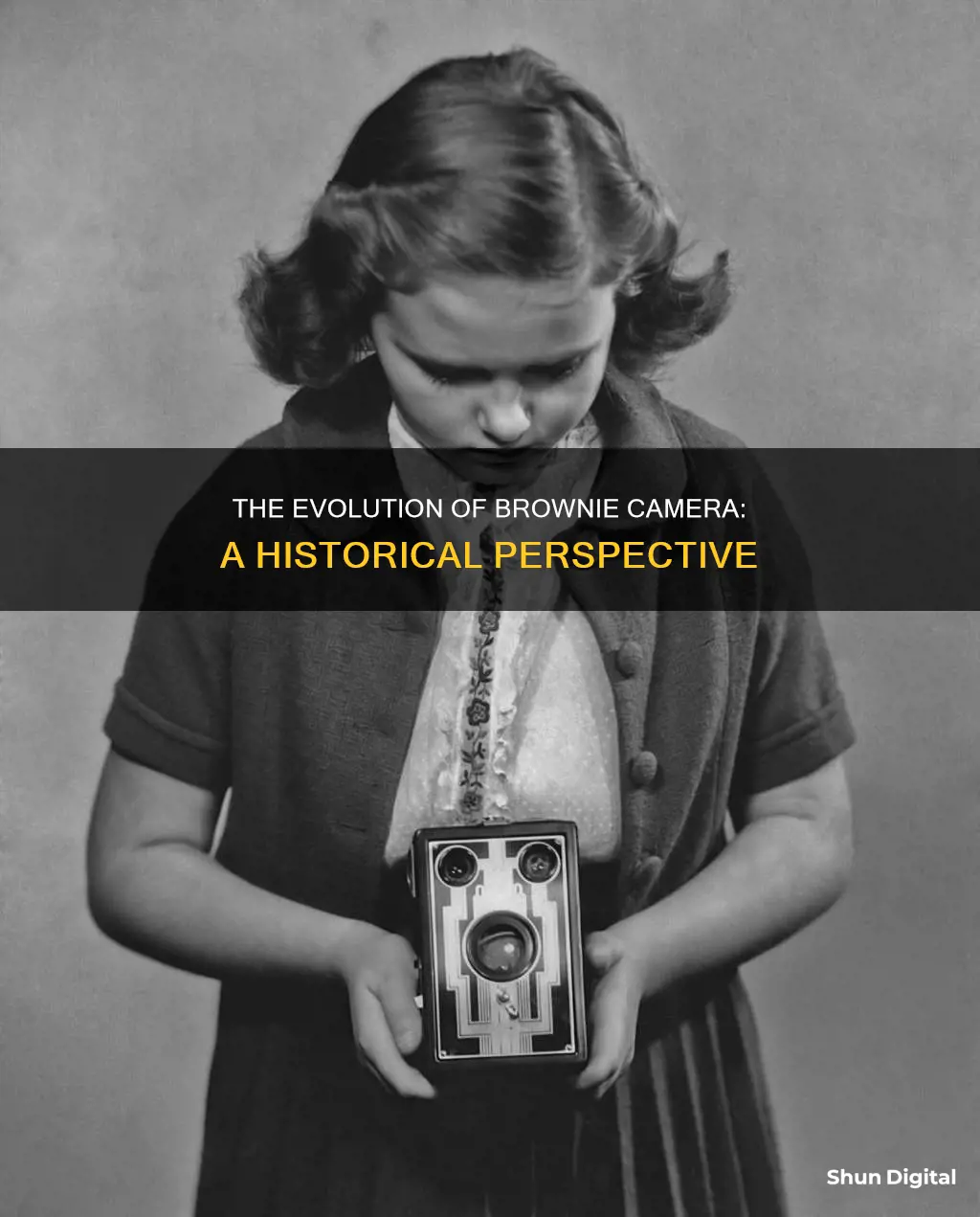
The Brownie camera was first introduced in 1900 by the Eastman Kodak Company. The camera was designed to be affordable and easy to use, with a simple box design and a price of just one dollar, making photography accessible to everyone, including children. The Brownie was a significant innovation, allowing people to capture candid moments and turning photography into an everyday activity. Over its 80-year history, the Brownie series included 125 different models, with the last official Brownie camera made in 1986.
What You'll Learn

The Brownie was a series of camera models made by Eastman Kodak
The Brownie was initially marketed to children, with Kodak using the camera to popularise photography. However, it achieved broader appeal as people realised that despite its simple design, the Brownie could produce good results under the right conditions. The camera's ease of use and affordability made it a huge success, with over 150,000 Brownie cameras shipped in the first year of production.
Over the years, Kodak released countless new models and updates to the Brownie, with more than 100 different models and variations manufactured over time. The No. 2 Brownie, released in 1901, introduced 120 film and produced larger 3.25-by-2.25-inch photos. The Brownie series continued to evolve, with new models introducing features such as built-in flash and different film formats.
The Brownie cameras played a significant role in democratising photography and challenging its privileged setup. They allowed people from all walks of life to capture candid moments and snapshots of their daily lives, preserving cherished memories for generations. The cameras were so ubiquitous that many iconic shots were taken on Brownies, including photographs of the iceberg that sank the Titanic and images from World War I battlefields.
The last official Brownie camera was the Brownie II Camera, a 110 cartridge film model produced in Brazil for one year, 1986, marking the end of a remarkable 80-year history of the iconic camera series.
Note 5 Camera: Features Beyond Standard Modes
You may want to see also

The first Brownie camera was introduced in 1900
The Brownie camera was introduced in February 1900 by the Eastman Kodak Company. The Brownie was the first model with a slide-on back, and it had a profound and far-reaching effect on the world. It democratised photography and made it accessible to the masses, including children, by addressing the cost factor.
The Brownie was a simple cardboard box camera with a convex-concave lens that took 2+1⁄4-inch square pictures on No. 117 roll film. It was designed by Frank A. Brownell and conceived as a tool to increase film sales. It was priced at $1 (equivalent to $37 in 2023) and marketed to children, taking its name from the popular Palmer Cox Brownie characters. More than 150,000 Brownie cameras were shipped in the first year of production.
The Brownie was extremely user-friendly and could be operated by anyone, even those who had never held a camera before. It invented point-and-shoot snapshot photography as we know it today. The film was also affordable, with a 6-exposure roll of transparent film costing just $0.15, paper-negative film $0.10, and processing $0.40.
The Brownie's introduction allowed anyone to afford a camera and film to capture family moments. It sparked a lifelong love of photography in many people and changed the world of photography forever.
Extending Camera Battery Life: Tips for Longer Shoots
You may want to see also

The Brownie camera was designed and marketed for children
The Brownie camera was an instant success, with approximately 150,000 cameras shipped in the first year of production. This success can be attributed to its affordability and ease of use. The camera was designed to be simple to operate, with a basic box design, an opening in the front for light to reach the film, a small viewing screen on top, and a switch to expose the film. The film came on easy-to-load rolls, and the entire package, including the camera, film, and processing, could be purchased for as little as $1.55.
The Brownie camera's mass appeal extended beyond children, as people of all ages recognised that despite its simplicity, it could produce good results under the right conditions. The camera's popularity grew, and it became a utilitarian item, accompanying people on vacations, cruises, and even to war. The ability to capture candid snapshots of everyday life and significant historical events became an important facet of the 20th century.
Over its 70-year production run, Kodak released countless new models and updates, with over 100 different Brownie models produced by the time production ended in 1986. The Brownie series turned photography into a beloved pastime, allowing people to create photo albums and preserve cherished memories of family, friends, and daily life.
Editing in Camera Raw: A Pre-Lightroom Must-Do?
You may want to see also

The Brownie camera cost $1
The Brownie camera, first released in 1900, cost just $1. This extremely low price, equivalent to $37 in 2023, meant that virtually anyone could afford a camera and film to capture family moments. The camera was the brainchild of George Eastman, who had invented roll film in 1884 and wanted to find a way to sell it to the masses, not just professional photographers.
The Brownie was designed by Frank A. Brownell, who was tasked with creating the least expensive camera possible while still making it effective and reliable. The camera was initially aimed at children, taking its name from the popular Palmer Cox Brownie characters. It was so simple to use that anyone could operate it, and it invented point-and-shoot snapshot photography as we know it today. The film was also affordable, and for $1.55, anyone could buy the Brownie, a roll of film, and get it processed.
The camera was a huge success, with more than 150,000 Brownie cameras shipped in the first year of production. It was a basic cardboard box camera with a simple convex-concave lens that took 2+1⁄4-inch square pictures on No. 117 roll film. Its simple controls, low price, and the low price of Kodak roll film and processing meant that the Brownie camera surpassed its marketing goals.
The Brownie's popularity continued, and it spawned many varieties, such as a Boy Scout edition in the 1930s and the Six-20 Flash Brownie in 1940, Kodak's first internally synchronized flash camera. In 1957, Kodak produced the Brownie Starflash, its first camera with a built-in flash. The Brownie 127 was also popular, selling in the millions between 1952 and 1967.
The last official Brownie camera was the Brownie II, produced in Brazil for one year in 1986.
ZS50: In-Camera Charging Supported?
You may want to see also

The Brownie camera was easy to use
The Brownie camera was introduced in February 1900 by the Eastman Kodak Company. It was an instant success, with 150,000 cameras shipped in the first year of production. The Brownie was easy to use, and its simple design made photography accessible to everyone, including children.
The Brownie was a basic cardboard box camera with a simple convex-concave lens. It was designed by Frank A. Brownell and was very simple to operate, even for those who had never used a camera before. It had a small viewing screen on top and a switch to expose the film. The film came on easy-to-load rolls and cost just $0.15 for a 6-exposure roll. The camera itself cost only $1, making it affordable for most people.
The Brownie camera was marketed specifically to children and families, with Kodak using the popular "Brownie" characters from Palmer Cox's children's books as mascots. Kodak encouraged children to enter picture contests and join Brownie clubs. This strategy helped to create a huge demand for films, as people could now take pictures casually and indulgently.
The Brownie camera's ease of use and affordability democratised photography and made it an everyday activity. It allowed people to capture snapshots of their daily lives and preserve cherished memories. The camera's popularity also led to the creation of 125 different models over a 70-year period, with the last official Brownie camera made in 1986.
Loading Batteries into Your DXG 552 Camera: A Step-by-Step Guide
You may want to see also
Frequently asked questions
The Brownie camera was first released in February 1900.
The Brownie camera was made by the Eastman Kodak Company.
The Brownie camera was invented by Frank A. Brownell.
The Brownie camera was originally priced at $1.
Approximately 150,000 Brownie cameras were shipped in the first year of production.







